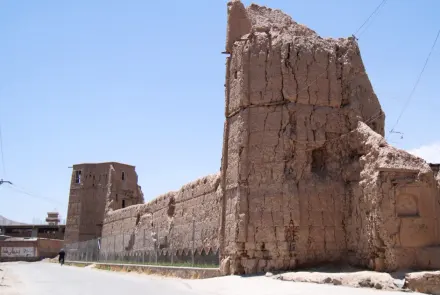The Noh Burja area of Chihil Sutun is one of the ancient parts of Kabul, with a history spanning nearly 200 years.
This historical area was constructed during the reign of Emir Dost Mohammad Khan by his elder brother, Nawab Jabarkhan.
Noh Burja of Chihil Sutun covers an area of 20,000 square meters and includes nine towers with tall walls.
Currently, four of the nine towers remain, and among these four, two are partially destroyed.
Ketab Khan Faizi, head of the Kushani International Research Center, said: “Noh Burja, Chihil Sutun, was built by the elder brother of Dost Mohammad Khan, Nawab Jabarkhan, between 1839 and 1843. It has nine towers and covers an area of twenty thousand square meters.”
Mohammad Anwar Faiez, a scientific member of the Archeological Research Center of the Academy of Sciences, said: “This must be preserved so it can be passed onto future generations to show what architectural art was like in the past.”
In the construction of Noh Burja, mostly stone and clay were used, and it was once the residence of the kings of the time.
“It is called Noh Burja [Nine Towers] because it has nine towers. Queens, kings, and chiefs lived here,” said Jamalluddin Siddiqi, a resident of Noh Burja of Chihil Sutun.
The towering walls of Noh Burja, with a thickness of three meters, provide a beautiful view of the area.
Meanwhile, the residents of Noh Burja called for the restoration of the towers of this historical area.
“Our request from the Islamic Emirate is that historical places should be restored and given attention so people can come to visit these places,” said Abdul Sabor Fedayi, a resident of Noh Burja.
“Serious attention should be given to these places because they are very important in the country,” said Naqeeb Ahmad Rahmani, another resident.
The officials from the Department for the Directorate for the Preservation of Historical Monuments at the Ministry of Information and Culture speak of having plans to restore the castle.
This historical monument of the country was constructed during the reign of King Amanullah Khan, to the southwest of Chahar Asyab in Kabul, a place previously known as Afshar Tepe.
The palace, strategically located at an elevation of 30 meters and covering an area of 1,400 square meters, was built by order of Amir Amanullah Khan. The construction work was started by 22 German architects under the supervision of German engineer Walter Harten and was completed in 1927 (1306 solar year ).
Sayed Shah Mahmood, a cultural expert, said: “The building was designed by Germans and Turks, but it was completed with the artistry of Afghan architects and carpenters.”
In the construction of this palace, materials such as mountain stone, marble, cement, plaster, and baked bricks were used, and its roof is adorned with wood and carpets.
Ketab Khan Fayzi, head of the Kushani International Research Center, said: “This palace has three stories and approximately 150 rooms, covering an area of 1,400 square meters.”
Despite enduring difficult periods, the palace, with its green surroundings, has now become one of the most pristine historical and tourist attractions in the capital.
Visitors to the palace have various stories about this historical place.
Navid Amanyar, a visitor, said: “We came today to visit Darul Aman Palace. The palace is among the ancient monuments.”
Another visitor, Abdul Qahar, said: “Visitors need a guide here to help them explore the place.”
Khubaib Ghofran, spokesman for the Ministry of Information and Culture, emphasizes the preservation of historical palaces in the country and says they are working to provide more facilities for visitors.
Ghofran said: “The Ministry of Information and Culture is committed to maintaining and restoring all historical monuments, palaces, and sites and always strives to protect these monuments and palaces.”
Abdul Qadeer Temori, an employee of the Department for the Directorate for the Preservation of Historical Monuments at the Ministry of Information and Culture, said: “The Department for the Directorate for the Preservation of Historical Monuments at the Ministry of Information and Culture has held several discussions with the Aga Khan Foundation and international companies regarding the preservation of this historical towers. Plans and maps for the restoration of Noh Burja have been created.”
Noh Burja of Chihil Sutun was used as a military stronghold during the wars of the 1990s, which led to significant damage to this historical fortress. Currently, more than 26 families live in the area.—Tolonews










